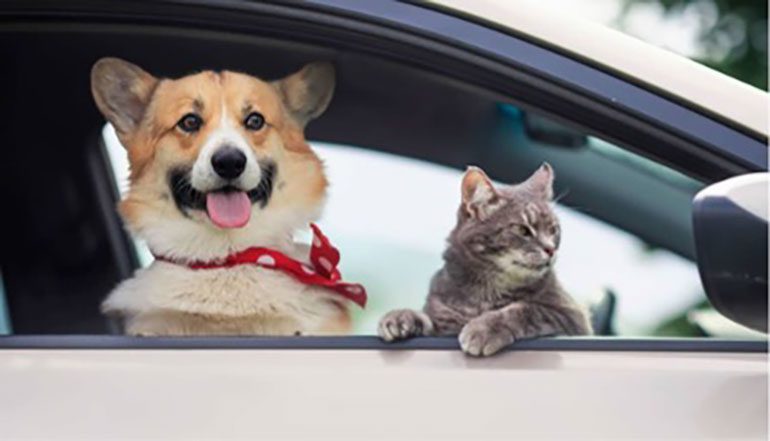Traveling can be a fun and enriching experience for humans, but for pets, the experience can vary dramatically. Factors such as mode of travel, destination and preparation can greatly affect your pet’s travel experience. If you’re considering taking a trip with your furry friend, this comprehensive guide will help you navigate the logistics and considerations needed for a smooth journey.
Things To Do Before You Go
A few of the things you should have on your checklist before voyaging with your little furry friends are mentioned as follows:
Talk to Your Vet
Before embarking on a journey with your pet, it’s crucial to consult your veterinarian. A check-up ensures your pet is healthy and fit for travel. Your vet can also give advice on how to handle potential challenges like motion sickness, anxiety and changes in altitude or temperature. Make sure to ask about necessary vaccinations and any other health concerns that might arise on your trip.
Get a Good Pet Insurance Plan
Pet insurance can be a lifesaver when you’re traveling. In case of an emergency, you want to be able to provide the best care for your pet without worrying about exorbitant costs. Some insurance plans even cover travel-related contingencies like trip cancellation due to pet illness. Research the best options to cover your travel plans and make sure to read the fine print.
Make Sure You Have ID Tags
ID tags are crucial for the safety of your pet. The tags should include your contact information, as well as any pertinent health details (like allergies or needed medications). Consider adding a temporary tag with the address and contact information for your destination.
Take Copies of Your Furry Companion’s Vaccination Records
You may be required to present proof of vaccinations at various points in your trip. Having a copy of your pet’s vaccination records can smooth over many logistical issues, especially if traveling internationally. Keep digital and physical copies handy.
Have Enough Pet Food
If your pet is accustomed to a specific type of food, make sure to pack enough for the duration of the trip. Sudden changes in diet can upset your pet’s stomach, which is the last thing you want while traveling.
Pack Necessary Medications and Prescriptions
If your pet is on medication, pack enough to last the trip and a little extra in case of delays. Carry a copy of the prescription as well, in case you need to get it refilled while you’re away.
How To Travel With Your Pet

Traveling with your pet can be an amazing adventure and experience for you as well as your furry companion. However, there are certain things that can help ensure that your trip sails smoothly without you having to worry about your little companion’s well-being or discomfort.
Preparation and Comfort
Before setting off, familiarize your pet with their traveling carrier or crate. Add a familiar blanket or toy to provide comfort. Keep a pet travel kit handy that includes water, bowl, leash, waste bags, grooming supplies and first-aid items.
Time and Timing
Pets, much like humans, can suffer from jet lag or stress due to abrupt changes in routine. Try to maintain a semblance of their regular feeding and bathroom schedule. For pets prone to anxiety, consider traveling during off-peak hours when there’s less noise and chaos.
How To Travel With Your Pet on a Plane
Choose the Perfect Means of Air Travel
Not all airlines are pet-friendly, and those that are, can have widely varying policies. Look for airlines that offer special services like climate-controlled cargo areas or the ability to bring small pets into the cabin. Most trips by plane are for international trips which can mean longer airtime and thus is crucial to ensure that your furry friend is safe and comfortable during the journey. The best option is to opt for an international private jet charter so you won’t have to worry about leaving your pet’s care in the hands of others and can have them right beside you all along.
Understand Cabin and Cargo Rules
Some airlines allow smaller pets to travel in the cabin in a secure carrier. Larger pets may need to travel in the cargo hold. Each has its pros and cons; for example, while the cabin is temperature-controlled and pressurized, space is limited.
Pre-Flight Preparations
Arrive at the airport early to give yourself ample time for the additional screening process that comes with traveling with a pet. Follow the airline’s guidelines for food and water intake before the flight. Exercise your pet to tire them out before the journey.
How To Travel With Your Pet in a Car

Secure Your Pet
It’s unsafe for pets to roam freely in a moving vehicle. Use a carrier or a pet seatbelt to secure them safely. Ensuring your pet is securely restrained in the vehicle is paramount for both their safety and yours. An unrestrained pet can be a distraction, and in the event of a sudden stop or accident, could become a dangerous projectile. Carriers are a good choice for smaller pets. Make sure that the carrier is well-ventilated and securely fastened to the vehicle. Some pet owners prefer vehicle pet barriers, particularly for SUVs and larger vehicles, which allow the pet to move a bit but not enter the front seat area.
Plan Pit Stops
Long car journeys can be taxing on your pet. They may need to stretch, relieve themselves or simply break the monotony. Make sure to schedule these breaks to align with your pet’s regular bathroom and exercise routine if possible. Remember that just letting your pet out into an unfamiliar area might not be the safest idea, so always keep them leashed during these breaks. The stops are not only beneficial for your pet’s physical well-being but also offer mental stimulation from the new scents and sights.
Keep Them Entertained
A bored pet can become restless, and a restless pet can become a nuisance or even a danger while driving. To avoid this, pack a variety of toys to keep them entertained. Squeaky toys and puzzle feeders can offer mental stimulation, while chew toys can help alleviate any stress or anxiety they may be feeling. It’s also a good idea to pack some of their favorite treats to reward them for good behavior, but be careful not to overfeed, as this can lead to an upset stomach.
How To Travel With Your Pet on a Train
Check Train Policies
Navigating the policies surrounding pet travel can be complex as it varies significantly from one train company to another. Some train services allow small pets in the cabin if they are confined to a carrier, while others may permit larger dogs but restrict them to the cargo area. Many companies also have breed restrictions and require documentation like health certificates or vaccination records. Some even have a “pet surcharge” you’ll need to pay in addition to your ticket. You should also investigate whether there are restrictions on the duration of travel for pets, as some companies don’t allow pets on longer routes.
Make Reservations Early
Train compartments designated for passengers traveling with pets often have limited availability. This is because not all cars on the train are equipped to accommodate pets, and among those that are, space is usually allocated on a first-come, first-served basis. Waiting until the last minute to book could result in disappointment if the pet-friendly options are sold out.
Prepare for the Journey
Trains often offer a smoother ride compared to cars or planes, but that doesn’t mean your pet will be any less anxious or bored. You’ll need to pack enough food for the duration of the journey, considering that train travel can often extend to several hours or even days. It’s also crucial to pack extra water, especially if you can’t rely on train facilities to provide it. Toys, like chew toys or interactive puzzles, can keep your pet engaged and relieve stress during the trip.
Conclusion
Traveling with pets requires extra preparation and consideration, but the rewards—a happy pet and happy memories—are well worth the effort. With proper planning, the right gear and a bit of foresight, you and your furry companion can have a safe and enjoyable journey together and make memories that will last a lifetime.



